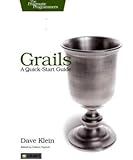SpringOne 2GX 2011
Chicago, October 25-28, 2011
Dave Klein
Author of 'Grails: A Quick-Start Guide'
Blog
?berConf - Exceeding Expectations
Posted 2010-06-15 12:47:23.0
ÜberConf kicked off yesterday with the pre-conference iPhone/iPad workshop. The workshop was completely full, with just over 90 people. The view from the front of the room was pretty impressive -- all those glowing applesmore »Recording of Grails / Terracotta webinar
Posted 2010-05-12 05:47:44.0
In case you missed it and in case you're interested, Terracotta has posted a recording of the webinar that Mike Allen and I held a couple weeks ago. You can catch it in all of its glory (or lack thereof :) at http://bit.ly/scaling_grailsmore »Presentations
Grails Quick-Start
You've heard about how easy it is to build web apps with Grails. Maybe you've even seen the simple CRUD app in a blink of an eye, but do you want to see what Grails is really capable of? Then join us as we walk through the construction of a real web appmore »Not Your Father's Custom Tags
One of the most compelling features of Grails is it's custom tag libraries. Yet many developers, especially those coming from a JSP or JSF background, run from the room screaming when someone suggests creating a custom tag. Grails custom tag libraries aremore »You've heard about how easy it is to build web apps with Grails. Maybe you've even seen the simple CRUD app in a blink of an eye, but do you want to see what Grails is really capable of? Then join us as we walk through the construction of a real web application with this powerful framework. Along the way we'll see how to take advantage of Grails' features like GORM, service classes, custom tags, and URL mapping.
You'll be amazed at how quickly you can become productive with Grails, not just because of scaffolding but because of the power of “Convention over Configuration,” sensible defaults, and the dynamic goodness of Groovy - all applied to a suite of the best tools in the industry, such as Spring, Hibernate, Tomcat, Ant, Sitemesh, JUnit, and more.

One of the most compelling features of Grails is it's custom tag libraries. Yet many developers, especially those coming from a JSP or JSF background, run from the room screaming when someone suggests creating a custom tag. Grails custom tag libraries are a powerful way to encapsulate business logic and keep code out of our pages. They are also great for declaring intent and making pages more readable. But here's the best part... they are ridiculously easy to create.
We will have a brief tutorial on creating Grails custom tags and then build a few to demonstrate just how easy it can be to tap into this powerful feature. We will also see how we can bundle our custom tags into a Grails plugin to reuse in our other projects or to share with the community.

Books
by Dave Klein
-
Grails is a full stack web development framework that enables you to build complete web applications in a fraction of the time and with less code than other frameworks.
In Grails: A Quick-Start Guide, you'll see how to use Grails by iteratively building an unique, working application. By the time we're done, you'll have built and deployed a real, functioning website.
Along the way, we'll learn about domain classes, controllers, and GSP views. We'll see how Grails allows us to use powerful frameworks like Spring and Hibernate without even knowing it.
Using this hands-on, pragmatic approach, we'll explore topics such as AJAX in Grails, custom tags, and plugins. We'll dig into Grails' powerful view technology, Groovy Server Pages, and see how we can easily leverage the help given to us by scaffolding to create custom user interfaces faster than you would have thought possible.
With Grails, you can get a lot done with little effort. With this book, you'll get a lot done as well. It's time to bring the fun back into web programming. Get started with Grails today.
-
Grails is a full stack web development framework that enables you to build complete web applications in a fraction of the time and with less code than other frameworks.
In Grails: A Quick-Start Guide, you'll see how to use Grails by iteratively building an unique, working application. By the time we're done, you'll have built and deployed a real, functioning website.
Along the way, we'll learn about domain classes, controllers, and GSP views. We'll see how Grails allows us to use powerful frameworks like Spring and Hibernate without even knowing it.
Using this hands-on, pragmatic approach, we'll explore topics such as AJAX in Grails, custom tags, and plugins. We'll dig into Grails' powerful view technology, Groovy Server Pages, and see how we can easily leverage the help given to us by scaffolding to create custom user interfaces faster than you would have thought possible.
With Grails, you can get a lot done with little effort. With this book, you'll get a lot done as well. It's time to bring the fun back into web programming. Get started with Grails today.
- NFJS SITES:
- No Fluff Just Stuff
- Uber Conf
- NFJS One
- SpringOne 2GX
- Rich Web Experience
- Project Automation Experience
- SPRINGSOURCE SITES:
- Springsource.com
- Springsource.org






